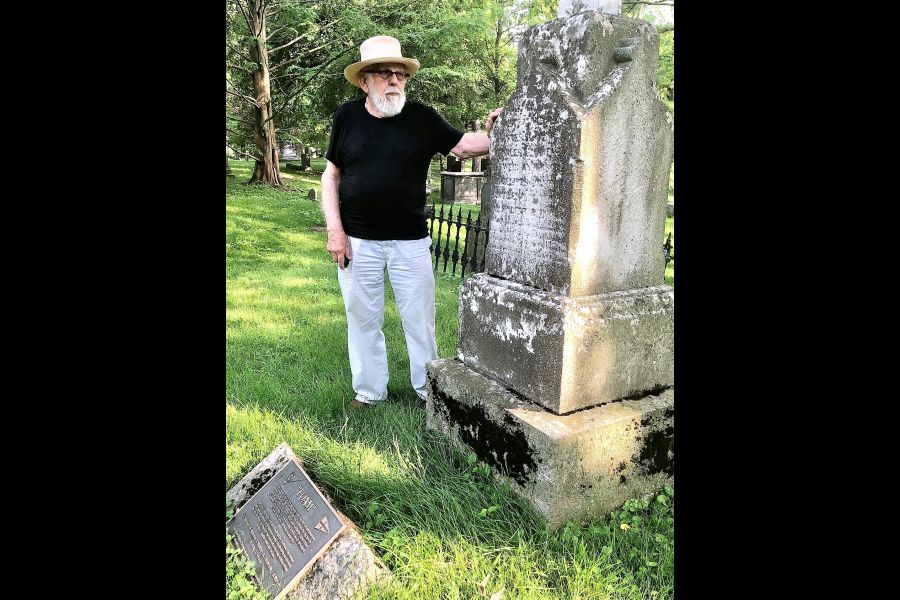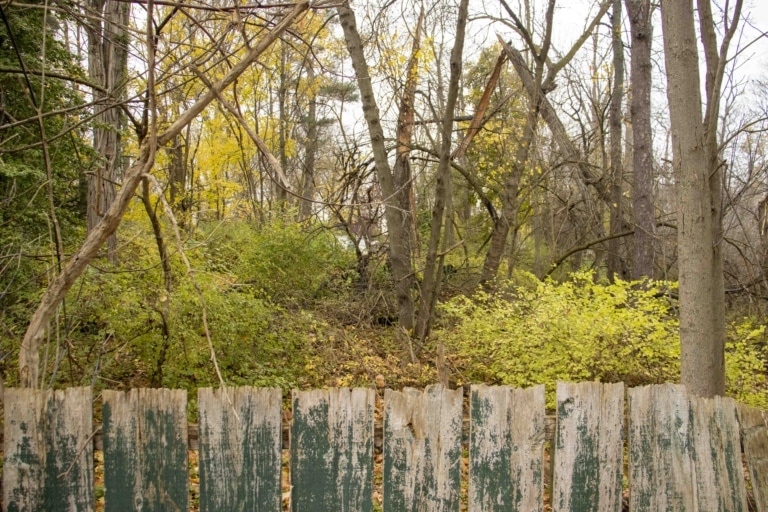On Saturday, July 11, 1874, the sloop Foam, with seven sailors aboard, sailing out of the Royal Canadian Yacht Club in Toronto, foundered on the Niagara Bar, within sight of its destination, the Queen’s Royal Hotel, on the western bank of the river, at Niagara-on-the-Lake.
All seven souls aboard were lost. All are buried in a small, respectful plot in the St. Mark’s church cemetery, still owned by the Royal Canadian Yacht Club.
The incident is shrouded in mystery and many fundamental questions remain impossible to answer …
The cemetery at St. Mark’s Anglican Church is considered the oldest in the province, recording its first burials in 1782.
It is nestled on a gently rolling, well-treed plot, just behind the church founded by Robert Addison a decade later. It has remained largely unchanged for almost 240 years.
The gravestones tell poignant stories of the life and times of the first capital of Upper Canada and all the decades since.
The cemetery is peaceful, almost bucolic, an oasis of calm amid small-town bustle.
It’s not surprising that Helen Ferley and her black cockapoo, Ambrose, are among a small legion of locals and tourists who wander the cemetery, looking for both history and serenity.
Ferley found the small fenced grave site of the Foam just this past spring while on her regular morning walk about town.
The gravesite, erected in 1874 or thereabouts, is some 36 feet by 25 feet, surrounded by a low wrought-iron fence, one whole section long-since removed. The central six-foot tall limestone monolith is cracked and largely unreadable, yet still reminiscent of its former grandeur.
Seven small headstones, each named for one of the Foam’s lost sailors, are placed in front of the monument, seemingly standing at attention, a place of prominence.
In the middle of the small site, a more-modern bronze plaque provides the scant details of the tragedy.
“Sometimes, I walk here just for the peace and quiet,” says Ferley, a native of Ireland, a pleasing back-home lilt still in her voice after almost 50 years in Canada.
“So beautiful. It’s manicured enough but not overly so. Nature has been left to do what it does so beautifully. It’s magical.”
In her mid-seventies, Ferley and her husband Stephen, came to Canada in 1974 “for two years,” she says with a smile. They moved to town about a decade ago.
She trained as an RN in Belfast and still works locally in diabetic education and palliative care nursing.
“I walk Ambrose twice a day. Sometimes something in the cemetery raises my interest.”
That was the case when Ferley discovered the gravesite of the Foam.
“First, I thought: ‘Where is the missing rail.’”
As she looked closer, the depth of the tragedy etched on the gravestones, pulled her in.
“I always find tragic, unexpected, sometimes avoidable deaths, very sad. Not just for the people who suffered, but for their family and friends. They probably thought they had the world at their feet.”
“And why were they buried in Niagara-on-the-Lake instead of Toronto?”
One of the official archivists for St. Mark’s has some of the same questions about the Foam.
Donald Combe just turned 90. He’s been a St. Mark’s parishioner for almost 55 years and actively involved in cemetery matters since 1985.
He’s written or co-written 16 books about St. Mark’s, including “Stones, Saints and Sinners,” the stories of 70 residents of the cemetery. He can recite the background for hundreds of gravestones.
“I probably know about this better than anybody,” he says, his small smile highlighting the understatement.
Combe recounts the story of how the Foam monument was misidentified for many years. It seems, during an inventory of the cemetery’s headstones, the decaying lettering was misread, making the date of the tragedy 1814 instead of 1874. In a town with so much War of 1812 history, it was probably not surprising.
During a storm in the winter of 2004 the finely carved Celtic cross atop the original monument was broken off and badly damaged.
Combe remembers the repairs were very difficult: “The monument was carved from one piece of stone. But the Royal Canadian Yacht Club (the home port of the Foam) owns the site. They paid for the repairs.”
The tombstone is still largely unreadable, but a large bronze plaque now attempts to set the record straight:
On the evening of July 11, 1874, the sailing yacht Foam left Toronto headed for Niagara-on-the-Lake. As darkness fell the wind freshened, blowing heavily from the east. Guests at the Queen’s Royal Hotel watched her lights flicker and disappear. Next morning, like and arm reaching to heaven, only the mast of the vessel showed above the breakers on the bar.
A typical centreboarder with light draught and low freeboard. Foam was an older yacht and laboured in the high seas running. Despite the heroic efforts of all her crew all aboard were tragically lost. Here rest seven young yachtsmen from the Royal Canadian Yacht Club, Toronto.
Combe grew up in Niagara Falls, becoming an English teacher. As a young boy, he frequently visited, with his grandmother, a huge cemetery near his home. She awakened his interest in history and cemeteries. “Grandmother weaved together family stories on the relatives buried there.”
“Part of the reason I love this cemetery is the aesthetic,” he gestures over the quiet landscape. “This is the original lay of the land. Nobody levelled it off. When Addison arrived in 1792, this is the way he found it.”
Combe can’t help a moment of promotion. He has a dogged determination to make sure the cemetery survives. All the financial and operational burden of the heritage gravesite falls on the church’s cemetery committee.
“I hope stories like this will get more people interested. I hope people will give us some money to keep it up. We’re fast running out.”
Today, Combe regularly leads tours of the cemetery. He always stops at the Foam gravesite.
“There’s got to be a story here somewhere,” he says. “They were all Toronto boys, why are they buried here?"
Barbara Worthy loves the mystery attached to the story of the Foam, too.
Worthy is a writer, director, producer and performer who came to town in 1985 to join the Shaw Festival. A former community journalist in western Canada, she has built an eclectic career including stints with the CBC, the Stratford Festival, and numerous other theatrical and production gigs around Ontario.
More recently, and among other things, she works part-time at the Niagara-on-the-Lake Museum. In addition to her administrative role, she has created numerous cemetery stories — both the writing and performing.
“I walk in the graveyard almost every day,” says Worthy. “I live just down the street.”
Like Ferley and Ambrose, she was captivated by the Foam story.
“How can you not be moved by (the story)?” she asks. “I spent a lot of time on it. I was very drawn to it. I went there, looked at the stones, wept over them. Found it all very moving."
“I just imagined that those girls were standing waiting. And those boys never showed up. The people were having this wonderful gay time and looking out, tinkling laughter, watching these pretty lights bobbing. They were actually watching the boat go down, without understanding.”
Worthy was so moved by the story, she created and produced a live cemetery tour with costumed actors, about the Foam. Then she turned it into a somewhat fantasized YouTube depiction, called “The Reporter.” Find it at youtube.com/watch?v=kSpkrPVegio.
As part of Canada’s 150 Celebration, Worthy also wrote and produced a song, “The Bankers Boys,” as part of “The Great Canadian Songbook.” It’s available at https://anchor.fm/canadian-songbook/episodes/Episode-7-Bankers-Boys-eo4ssf. It was performed around Niagara during the celebrations.
Worthy lists just some of the mysteries that remain:
“There were so many varying reports. What was the time it happened? Where were the bodies found? Was there something wrong with the boat?”
You can tell the discussion has piqued her creative interests anew. She seems to know there is still a future for this heritage tale.
“There’s a movie in there. There’s a Netflix show."
Next: Although the Foam is part of the sailing lore of the Royal Canadian Yacht Club in Toronto, the club’s archives shed little light on what happened that fateful July day in 1874. The final part of The Lake Report’s saga of The Sinking of the Foam explores what is known and discovers a fledgling plan to commemorate the 150th anniversary of the sinking of the sloop.










